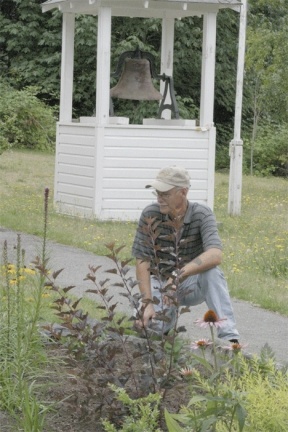Bayview School has sprouted a new look.
Not far from the signature bell tower on the building’s west side is a newly-planted rain garden.
The roughly 100-square-foot rain garden is intended to capture a portion of the stormwater runoff generated by the high school, clean it and slowly let it get absorbed into the ground.
Earlier this summer, the Whidbey Island Conservation District partnered with Goosefoot Community Fund, the Puget Sound Partnership and local volunteers to construct the unique garden at the school.
The new rain garden at Bayview captures the rain water that falls on part of the building by connecting a downspout to the garden. The garden is located at the bottom of a small hill so some additional surface water run-off will also be captured and cleaned.
“It’s beautiful, we love it and we’re pleased they chose us,” school director Scott Mauk said. “It makes the whole west side look great.”
Mauk noted that the school district plans to follow up in the fall with sprucing up the school by pressure washing the building and giving it fresh paint.
School district superintendent Fred McCarthy was on hand to help with the construction of the rain garden and expressed his appreciation to the volunteers.
Much of the financial support for this project came from the Puget Sound Partnership.
“Rain gardens are a wonderful way to improve the aesthetic value of an area, while also improving the environment,” said Linda Lyshall of the Puget Sound Partnership.
Landscape designer Sara Birger of Taproot Design in Langley helped choose the plants, a mixture of drought-resistant shrubs and perennials including nine-bark, brown-eyed Susan, mahonia, gayfeather, spiria and snow berry.
Birger hopes people will stop by to check out the garden.
“Touching, seeing and smelling someone else’s project before jumping in is a smart thing to do,” she said. “It was a great learning experience for everyone.”
Goosefoot has been monitoring the garden throughout the summer.
“The rain garden is a beautiful and educational demonstration,” said Debbie Torget, chief operating officer for the nonprofit. “Goosefoot was very happy to participate.”
Goosefoot facilities manager Rob Bangert has been keeping track of the garden during the summer.
“There’s a timer drip system but mainly we rely on the rain to keep the plants healthy,” Bangert said.
A typical rain garden is a man-made depression in the ground used as a landscape tool to improve water quality. The garden forms a “bioretention area” by collecting water runoff and storing it, letting it be filtered and slowly absorbed by the soil. The bioretention concept is based on forest habitat in which the forest produces a spongy litter layer that soaks up water and allows it to slowly penetrate the soil layer.
A filtering process takes place as the water comes in contact with the soil and the roots of the trees, shrubs and vegetation resulting in improved water quality. The first flush of rain water is ponded in the depression of the rain garden and has the highest concentration of materials washed off impervious surfaces such as roofs, roads and parking lots.
The problem facing any community is run-off. Once a piece of property is developed, the hard surfaces — streets, parking lots, roofs or sidewalks — don’t allow the run-off to be absorbed back into the soil and cleaned. The hard surfaces also increase the speed of the run-off. Oil, metals and pollutants on those surfaces move with the rainwater runoff as it makes its way to underground pipes and into Puget Sound.
Researchers estimate that water from a 1-acre parking lot is about 16 times greater than from a meadow of the same size.
The conservation program was managed by Kelly Donahue.
“Rain gardens are one example of a tool that can be installed just about anywhere,” Donahue said. “We hope this garden will inspire residents of Whidbey Island to construct rain gardens at their homes.”
For more information, contact Karen Bishop at karen@whidbeycd.org or call 360-678-4708.



